
Lomatium utriculatum is a species of flowering plant in the carrot family known by the common name common lomatium or spring gold. It is native to western North America from British Columbia to California, where it grows in many types of habitat including chaparral, and in the Sierra Nevada.
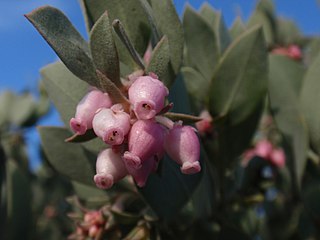
Arctostaphylos canescens, common name hoary manzanita, is a species of manzanita.
Arctostaphylos malloryi is a species of manzanita known by the common name Mallory's manzanita. It is endemic to California.
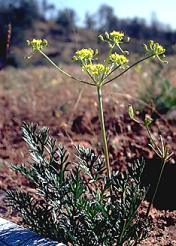
Lomatium congdonii, known by the common names Mariposa desertparsley and Congdon's lomatium, is a species of flowering plant in the carrot family.

Lomatium foeniculaceum is a species of flowering plant in the carrot family known by the common name desert biscuitroot. It is native to much of western and central North America, where it grows in many types of habitat.

Lomatium caruifolium, known by the common name alkali desertparsley, is a species of flowering plant in the carrot family.
Lomatium ciliolatum is a species of flowering plant in the carrot family known by the common name Yolla Bolly biscuitroot. It is endemic to California, where it is known from the mountain ranges adjacent to the north and south of the San Francisco Bay Area, at 300–600 feet, 1200–2100 m. It is often a member of the serpentine soils flora in woodland and chaparral habitat.
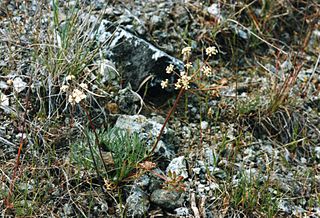
Lomatium engelmannii is an uncommon species of flowering plant in the carrot family known by the common name Engelmann's desertparsley, or Engelmann's lomatium. It is native to the Klamath Mountains of southern Oregon and northern California, where it is a member of the local serpentine soils flora.
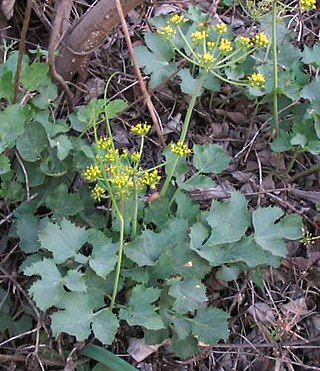
Lomatium lucidum is a species of flowering plant in the carrot family known by the common name shiny biscuitroot. It is native to coastal mountains and canyons of southern California and Baja California, where it is a member of the chaparral plant community, including recently burned areas. It is found in the eastern Transverse Ranges and the South Coast region.
Lomatium marginatum is a species of flowering plant in the carrot family known by the common name butte desertparsley. It is endemic to California, where it is known from mountains, valley, and grassland habitat, including serpentine, in the northern half of the state. It is a perennial herb growing up to about half a meter tall from a small taproot. There is no stem, and the leaves and inflorescence emerge from ground level. The purple-green leaves may approach 30 centimeters long, their blades divided into many long, narrow segments. The short but wide inflorescence bears an umbel of yellowish, purplish, or reddish flowers. The Lomatium marginatum is not currently an endangered species.

Lomatium martindalei is a species of flowering plant in the carrot family known by the common names Cascade desertparsley and coast range lomatium, native to western North America.

Lomatium mohavense is a species of flowering plant in the carrot family known by the common name Mojave desertparsley. It is native to southern California with a few outlying populations in Arizona, Nevada and Baja California. It is found in several types of mountain and desert habitat, including chaparral, woodland, and scrub, mostly from 2,000–7,000 feet (600–2,100 m) elevation.
Lomatium shevockii is a rare species of flowering plant in the carrot family known by the common name Owens Peak desertparsley, or Owens Peak lomatium. It is endemic to Kern County, California, where it is known from only two occurrences at Owens Peak, one of the highest points of the Sierra Nevada. It is a plant of the talus and wooded slopes of the high mountains. This species was discovered in 1984 and first described to science in 1988.

Lomatium tracyi is a species of flowering plant in the carrot family known by the common name Tracy's desertparsley, or Tracy's lomatium. It is native to the mountains of northern California and southern Oregon, where it grows in the forests on the slopes, often on serpentine soils. It is a perennial herb growing up to 35 centimeters tall from a slender taproot. There is generally no stem, the leaves and inflorescence emerging at ground level. The leaf blades are divided and subdivided into a mass of overlapping threadlike to oval segments. The inflorescence is an umbel of yellow flowers.

Lomatium triternatum is a species of flowering plant in the carrot family known by the common name nineleaf biscuitroot. It is native to western North America from British Columbia to California to Colorado, where it grows in many types of habitat. It is a hairy perennial herb growing up to a meter tall from a taproot. The leaves emerge from the lower part of the stem. Each is generally divided into three leaflets which are each subdivided into three linear leaflike segments. The inflorescence is an umbel of yellow flowers, each cluster on a ray up to 10 centimeters long, altogether forming a flat formation of umbels.

Lomatium vaginatum is a species of flowering plant in the carrot family known by the common name broadsheath desertparsley. It is native to northern California and adjacent sections of Oregon and Nevada on the Modoc Plateau. It grows in sagebrush, woodland, and other local habitat. This is a perennial herb growing up to 45 centimeters long from a thick taproot. The leaf blades are divided and subdivided into narrow segments. Leaves higher on the stem are enclosed in sheaths. The inflorescence is an umbel of yellow flowers.

Lomatium observatorium is a rare species of flowering plant in the carrot family known by the common names Mt. Hamilton desertparsley and Mount Hamilton lomatium. It is endemic to California, where it is known only from the mountains of Santa Clara County, including Mount Hamilton near the Lick Observatory. It may also occur in Stanislaus County. Its habitat includes mountain woodlands on volcanic and metamorphosed sedimentary rock substrates. Described The plant to science as a new species in 1996, the plant is a perennial herb growing low to the ground, the lightly hairy herbage growing from a long taproot.
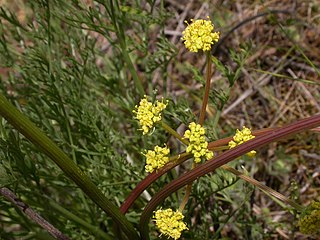
Lomatium cookii is a rare species of flowering plant in the carrot family known by the common names Cook's lomatium and agate desertparsley. It is endemic to Oregon in the United States, where it grows in only two valleys. It is a federally listed endangered species.
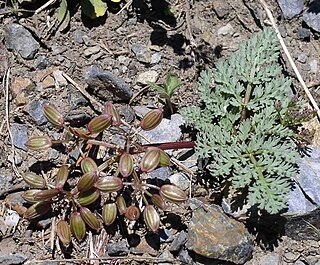
Lomatium erythrocarpum, known by the common name redfruit desertparsley, is a rare species of flowering plant in the carrot family. It is endemic to Oregon in the United States, where it is limited to a section of the Blue Mountains within Baker County.

Lomatium greenmanii is a rare species of flowering plant in the carrot family known by the common names Greenman's desertparsley and Greenman's biscuitroot. It is endemic to Oregon in the United States, where it is found only in the Wallowa Mountains of Wallowa County.
















